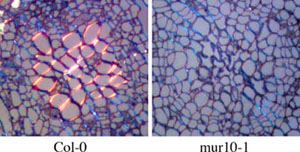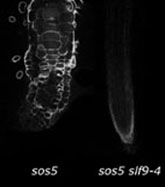Georg Seifert
Pflanzenzellwand
Gebiet
Gebiet
Zellbiologie, Zellwand der Pflanze, Arabidopsis Genetik
Leiter: Dipl.-Ing. Dr. Georg Seifert
Ausrichtung
Plant cell walls represent the world’s most abundant natural resource for fuel, fibre, food and fodder. Despite the cell wall’s importance for human society much remains to be learned about its biosynthesis and its central role in plant life. Cell walls consist of cellulose microfibrils that are embedded in an amorphous matrix of cross-linking glucans, acidic pectins and highly glycosylated proteins such as extensins and arabinogalactan-proteins. The work of this group is dedicated to better understand the biosynthesis and functions of cell wall matrix polymers. One of our areas of interest is the regulation of cell wall carbohydrate precursor metabolism by multiple isoforms of nucleotide sugar interconversion enzymes, potentially leading to approaches to modulate cell wall matrix composition and thereby improving processing properties. Another long-term interest of our group is the investigation of plant cell wall performance and integrity control. This process that is best understood in yeast, is predicted to control plant growth in response to abiotic stress and pathogen attack. Its elucidation promises strategies to make crop biomass production less sensitive to abiotic stress.

Figure 1: Polarized light micrography of hypocotyl sections of a wild type plant (left) and the mur10 mutant (right) that lacks secondary cell wall specific cellulose synthase. Strongly birefringent normal secondary cell wall produces polarization contrast while mutant secondary cell walls only contain ligin (dark blue). Bosca et al (2006) Plant Physiology 142:1353ff

Figure 2: Immunosilver labelled cell wall matrix polymers in secondary thickened hypocotyls in Arabidopsis thaliana wild type and mutant plants defective in UDP-galactose biosynthesis. Roesti et al (2007) The Plant Cell 19:1565

Figure 3: Mutations in the arabinogalactan-protein FLA4/SOS5 causes oversensitivity to salt, resulting in abnormally swollen and highly autofluorescent roots (left). Secondary mutations in several suppressor loci of fla4 (SLOF) restore wild type responsiveness to salt (right). SLOF genes are predicted to act in cell wall performance and integrity control. Seifert et al. (2010) Cell Wall Meeting 2010 Porto, Portugal


